Take care of yourselves and, once you and your loved ones are safe, remember our birds and consider their plight.
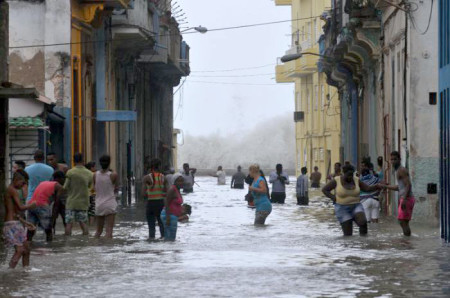
There is no doubt that the landscape on some islands has already changed, perhaps irreversibly so, after the passage of the strongest hurricane on record in the Caribbean. The Codrington Lagoon on Barbuda, for example – a beautifully preserved RAMSAR site – is home to the largest colony of Magnificent Frigatebirds in the region (around 2,500 pairs). It was breached during the storm and the sea has flowed in. Barbuda itself is now a scene of devastation, with almost all buildings damaged or destroyed and most inhabitants evacuated. So, what of the endemic Barbuda Warbler, a small bird that is Near Threatened (likely less than 2,000 individuals) – did it survive?
Moreover, human activity is already contributing to the changing island landscape on a perhaps unprecedented level. Barbuda itself is the proposed site of a tourism development that has already triggered controversy because of its possible impact on its fragile environment. Other large tourism and housing developments, mining and other industrial activities and urbanization are all threatening bird habitats across the region. The unchecked over-development of the Houston area, which replaced wetlands and woodlands with concrete was a major contributing factor to the excessive flooding.
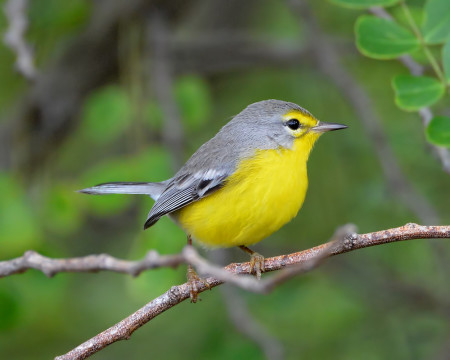
While discussion and research into the impact of climate change on tropical weather patterns (in particular, the link to hurricanes) continues, issues such as rising sea levels and warming seas are becoming increasingly evident in the Caribbean. All of these factors combined increase the chance that a single event like Hurricane Irma may cause a species, such as the Barbuda Warbler to go extinct.
Last year, we recorded the devastating impact of Hurricane Matthew on birds in the Bahamas and Haiti, in particular. We also noted that some species “bounce back” more quickly than others. After the storm passes, those birds that survive face long-term problems. In the path of the storm, trees and shrubs lose all their leaves, buds, flowers and fruits. Trees (often the older, larger trees that provide food and shelter) may be uprooted. Riverbanks are scoured and whole neighborhoods transformed. In hills and mountains, there is the threat of landslides. Damage to reefs and seagrass beds may decrease marine productivity. Nesting beaches may be washed away. Birds may lose their nests, shelter and food. Others get displaced to new areas, where they may not thrive.
What happens to birds in a hurricane?
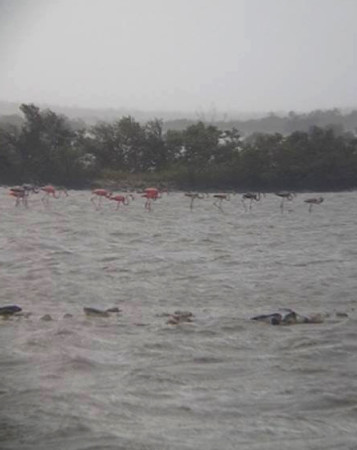
We know that many species can respond to the indicators that a storm is nearby, such as a drop in barometric pressure, changes in temperature, rainfall and light. In some species these changes trigger them to change location. The Bahamas National Trust notes that its flamingoes, for example, will fly away ahead of a storm and some seabirds on the wing will increase their altitude to try to get above the storm. Many other species respond to threats by trying to hunker down in safe places. Migratory birds may change their plans, and depart earlier than usual. Some very brave Whimbrels have even been recorded flying directly into a storm – for example, one named Chinquapin, braved Hurricane Irene in 2011. Read more here.
During and just after the passage of Hurricane Irma, Bahamian flamingoes were spotted, sheltered by coastal forest and mangroves, in storm conditions on the island of Great Inagua; and Cuban Parrots (Bahamas subspecies) were seen feeding on guinep fruit off the trees, which had somehow managed to retain its fruits. Some birds are true survivors, but with such a large and powerful storm as Irma, nowhere is entirely safe. Evidence is just now coming to light that many birds were killed outright during the storm, including thousands of flamingos in the Cayo Coco Cays of Cuba. Juvenile birds will fare worse than the adults. Often the impacts – on breeding cycles, for example – are indirect and more long term.
In 1998, Hurricane Gilbert displaced Black-billed Streamertail hummingbirds about 35 miles east from the dense wet limestone forests of eastern Jamaica to Kingston. A kind citizen found many of these streamertails on her veranda, weak and hardly able to fly. She went from putting out two or three small bottles of sugar water to supplying more than 2 gallons a day. Her efforts undoubtedly saved hundreds of birds.
What can we do to help birds after a hurricane?
It may take weeks, months or decades for our forests, wetlands and gardens to return to their former glory. In the meantime, you can do a lot to help your local birds.
-
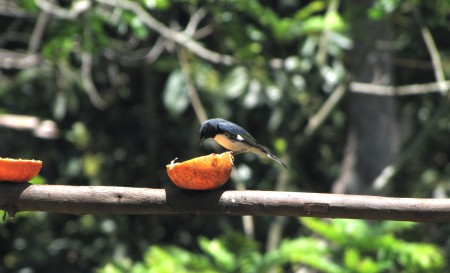
A Black-throated Blue Warbler feeding on fruit; this species winters in the Caribbean. (Photo by Anne Sutton) Remember the birds as you stock up with supplies, and maintain your hummingbird and seed feeders and bird baths.
- Provide food for birds following the storm. Feeding birds does not require expensive feeders or equipment.
- Seeds. Many pigeons and doves will eat cracked corn and small seed-eaters will take cracked rice. Watch out for changes in bird behaviour which may indicate food shortages. For example, White-crowned Pigeons may suddenly start feeding on the ground. If you see this, put out food in suitable places (ideally where birds are not vulnerable to cats).
- Sugar water. You can make a hummingbird feeder from a bottle with a screw on cap by piercing a small hole in the cap. Fill it with sugar water (1 part sugar to 4 parts water). Use some wire to suspend the bottle at an angle in a place where hummingbirds will find it. You may need to put something red on the bottle to attract the birds initially.
- Fruit. To provide fruit for birds, use a horizontal stake with 2 inch nails driven into it to put out left over fruit skins for birds.
What else can we do?
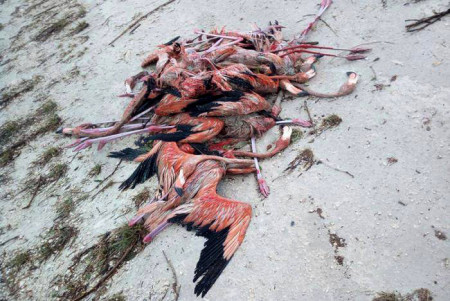
We need to document the impacts of hurricanes on birds so that we can determine which species have been affected and what we can do to help them. As soon as you can after the storm, take photographs and videos or take notes about:
- the extent of damage to habitats (and the process of recovery);
- observations of unusual behaviour by familiar birds;
- observations of threatened or rare species in their habitat (that might indicate that they survived);
- observations of dead birds; and
- observations of unusual birds that may have been blown into your area by the storm ( see also http://birdcast.info/forecast/hurricane-irmas-impact-on-birds/).
Please also enter your observations into eBird Caribbean. You may also post your photos and observations on the BirdsCaribbean Facebook page, twitter (@BirdsCaribbean) and BirdsCaribbean Listserv (or send to Lisa.Sorenson@BirdsCaribbean.org).
Note that because birds may travel to or get blown off course to other islands during storms and hurricanes, it’s just as important to survey birds in other islands that were NOT affected. For example, the more southern Lesser Antillean islands (Grenada, St. Lucia and St. Vincent and the Grenadines) may serve as a refuge from hurricane events. Please go out and do some surveys and keep an eye out for different birds and vagrants in your islands!
Donate to help our Caribbean partners and birds recover
BirdsCaribbean has launched a fundraising effort for hurricane relief for our Caribbean partners and birds. All the funds will be distributed to bird conservation partners across the Greater and Lesser Antilles islands to help them get back on their feet and replace what was lost in the storm—from notebooks, materials and binoculars to offices and infrastructure. The Fund will also support field surveys to assess the status of endemic, resident and many migrant species, as well as recovery and habitat rehabilitation actions by our partners, such as planting native trees that feed birds and provide habitat. Sincere thanks to those that have donated already!
In the long-term
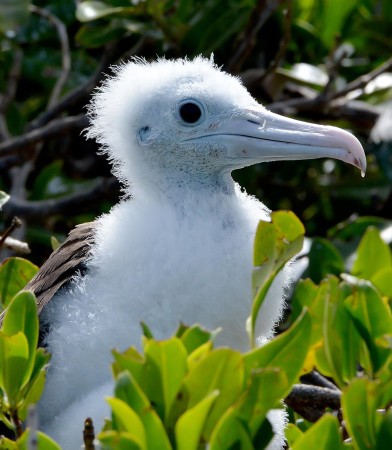
We need to take the opportunity to remind our policy-makers of the importance of maintaining and protecting our natural areas, and to continue public education among stakeholders. Intact mangroves provide the most effective protection from storm surge for coastal settlements and infrastructure. Wetlands soak up and store excess rain and protect surrounding areas and property from flooding. Forests prevent land slippage and flash flooding. Caribbean residents – whether town dwellers, farmers or fishermen – are seeing this for themselves in their daily lives.
Hurricane Irma will perhaps serve as a reminder that the delicate balance of our widely varied ecosystems is in jeopardy. As the University of Oklahoma’s Jeremy D. Ross notes in his September 9 article, if we do not maintain a healthy natural environment, “We stand to lose not just an isolated songbird most people have never heard of, but potentially the vibrancy of entire ecosystems that provide the Caribbean its inherent allure.”
By Emma Lewis, Ann Sutton and Lisa Sorenson
